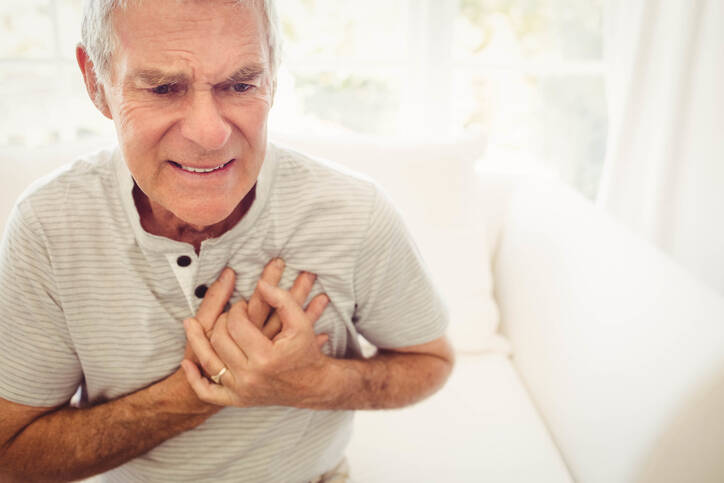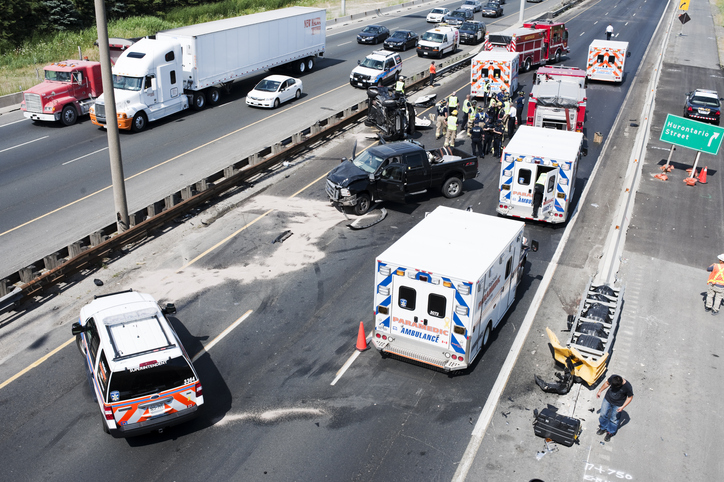- Literature: Pre-hospital emergency medicine, Viliam Dobiáš, and the team
- wikiskripta.eu - about shock
- ikem.cz - about BYPASS
- lf.upjs.sk - specialists in cardiogenic shock in pdf
Cardiogenic Shock: What Are The Causes And Symptoms? + Treatment

Heart attack or heart failure can go into cardiogenic shock. Especially when neglecting early treatment is neglected. However, there are other reasons for its emergence.
Most common symptoms
- Chest pain
- Spirituality
- Head spinning
- Bleeding
- Malaise
- Blue leather
- Sweating
- Yellowish skin
- Low blood pressure
- Lung Island
- Swelling of the limbs
- The Island
- Disorders of consciousness
- Cold extremities
- Muscle weakness
- Pressure on the chest
- Fatigue
- Anxiety
- Coughing up blood
- Urinary retention - anuria/retentiveness
- Confusion
- Accelerated heart rate
- Heart enlargement
Characteristics
Cardiogenic shock is a serious complication of some cardiovascular diseases. Thanks to modern times and effective treatment, it does not occur as often. However, if treatment is neglected or delayed, it ends in death.
What is cardiogenic shock and what does the word shock actually mean?
What does the word SHOCK mean from a medical point of view?
Shock.
In most cases, we use this word to refer to a variety of mental reactions. For example, stressful or surprising.
However, from a medical point of view, it has a completely different meaning.
Also read: Article in the Illness - Shock section.
The definitions of shock are diverse:
Shock is a life-threatening condition when tissue and organ perfusion occurs. If left untreated, organs (their functions) and organ systems gradually fail. It affects vital organs such as the brain, heart, lungs, or kidneys.
Or ...
Shock is a disparity between the body's needs and the supply of oxygen or nutrients.
But also ...
Shock is acute (sudden), or even subacute, a change in microcirculation and macrocirculation, which is manifested by a reduction in blood flow to tissues and organs. There is not enough oxygen in the cells, this condition is called hypoxia, and they accumulate toxic metabolic products.
It progresses to a malfunction of cells, organs, and entire organ systems. If left untreated, irreversible, ie irreversible, damage to the organs occurs such as the brain, heart, lungs or kidneys, and liver.
Why does the shock arise?
The reasons behind this can be various. Examples are major external bleeding, internal bleeding, fractures, gastrointestinal diseases, prolonged diarrhea, vomiting, and dehydration, as well as heart attacks and allergic reactions.

According to the cause, the shock is further divided.
The table shows the distribution of the shock by cause
| Main category | The name of the shock | Causing cause |
| Lack of blood in the blood vessels and in the absence of fluids in the body In general, we find it under the designation - Hypovolemic shock (inaccurate designation) | Hemorrhagic |
bleeding, which can occur, for example, when:
|
| Traumatic | in case of injuries:
| |
| Burns |
occurs in all serious burns
| |
| Hypovolemic |
with a reduced volume of fluid in the body, if sufficient replacement of lost fluids is not ensured
| |
| Insufficient cardiac output per minute
- Insufficient function of the heart as a pump and reduced amount of blood expelled into the body from the heart There is a sufficient volume of blood in the vessels | Cardiogenic |
|
| Obstructive |
| |
| Peripheral disorder also referred to as distributional shock There is enough blood in the vessels, not caused by bleeding or heart failure like a pump | Anaphylactic |
in case of a severe allergic reaction, ie anaphylaxis, for example after allergy to:
|
| Toxic | in chemical intoxication but also in pancreatitis | |
| Septic | Sepsis, we know the term blood poisoning as a complication of some infections | |
| Neurogenic | For brain and spinal cord injuries - in the neck and chest | |
| Endocrine |
in case of dysfunction of endocrine glands
|
Phases of shock
The shock has several phases. It does not occur immediately in mortal form. However, rapid and effective treatment will prevent the transition to its irreversible part. We know the phase of compensation, decompensation, and the irreversible phase.
Phases of shock in the table
| Phase | Description |
| Compensatory |
|
| Decompensation |
|
| Irreversible |
|
What are the symptoms of shock?
Shock manifests itself in several parts of the human body. The changes begin gradually, and if left untreated, so-called multiorgan failure occurs, also referred to as MODS - multiorgan dysfunction syndrome. Eventually, the death of the affected person.
What we can observe in shock:
- respiration and lungs
- respiratory acceleration - tachypnoea
- reduced blood flow to the lungs leads to their damage, shocks lungs to respiratory failure
- heart and cardiovascular system
- acceleration of heart activity - tachycardia
- accelerated pulse that is shallow
- followed by a filamentous pulse, when palpable the pulse is difficult to feel and weak
- to an intangible pulse
- arrhythmias for heart failure
- low blood pressure
- consequently to immeasurable blood pressure
- skin changes
- pallor
- up to cyanosis, ie blue discoloration of the skin of fingers, lips, nose, ears, mucous membranes of the oral cavity
- increased sweating
- cold sweat
- cold limbs
- cold skin
- neuro - mental changes and the brain
- restlessness
- confusion
- fear of death
- apathy
- drowsiness - somnolence
- disorder of consciousness, unconsciousness - coma
- cerebral infarction may develop, ie a stroke due to bloodlessness
- kidneys - for reduced blood flow occurs:
- reduction of urine production - oliguria
- to stop urination, urine production - anuria
- if renal ischemia lasts more than 90 minutes - kidney failure - shock kidney
- liver - reduced blood flow and function
- leakage of toxic substances into the blood
- jaundice, ie yellowing of the skin and yellow whites of the eyes, may occour
Commonly we could have heard expressions such as anti-shock measures or anti-shock position (in a position lying on the back - lifting the lower limbs above the plane, to about 30cm above the mat). However, the treatment of shock is complex, complex and depends on the underlying cause.
It is necessary and very important that the therapy is given on time and without time delay. Otherwise, the shock goes into an irreversible phase and death ensues.
Cardiogenic shock is ...
Defined as:
A state of critical reduction in blood flow to tissues, organs, and organ systems due to reduced cardiac output.
There is no reduction in circulating blood volume, as is the case with bleeding.
The heart fails like a pump.
The following criteria are used to assess cardiogenic shock:
- systolic blood pressure is less than 90 mmHg for at least 30 minutes
- or the use of vasopressors
- for a final value higher than sTK 90 mmHg
- on blood pressure values in a clear table
- blood stasis is associated behind the left ventricle
- blood pressure in the lungs rises
- risk of pulmonary edema
- reduction in the blood supply to tissues and organs when at least one of the following symptoms occurs:
- cold and sweaty skin
- oliguria, thus reducing urine output
- change of psyche
- increased value of lactate - metabolic product
It occurs in about 4 - 9% of cases of acute myocardial infarction. Mortality in the first 4 hours is reported to be 20-35%. Subsequently, the risk increases to 40-60%. In case of arrhythmia above 80%. Unsuccessful treatment 100%.
The risk of death is increased by old age, brain damage due to bloodlessness, severe left ventricular systolic disorder, renal failure or high lactate levels.
Causes
Cardiogenic shock is caused by a variety of causes. The heart's function as a pump then fails. The heart is unable to supply the body with circulating enough blood.
Blood is a carrier of oxygen and nutrients. In order to get into the whole organism, the heart has to pump it.
Cells, tissues, organs, and whole organ systems are non-oxygenated, ischemic, have no nutrients to work, and accumulate fumes, ie toxic substances, metabolism.
The most common causes of cardiogenic shock are:
- most often in heart muscle infarction
- 80% of all in acute left ventricular infarction
- large-scale infarction - affecting 40% or more of the left ventricle
- right ventricular infarction
- heart failure
- acute decompensation of chronic heart failure
- or acutely caused for another cause
- mechanical complication, for example in:
- Mitral regurgitation - valve defect, aortic insufficiency
- damage to the interventricular septum
- heart wall rupture
- severe cardiac irregularity - malignant arrhythmia
- myocarditis - inflammation of the heart muscle
- endocarditis - inflammation of the endocardium - the internal mucosa of the heart
- cardiomyopathy
- heart contusion - at injuries
- obstruction in cancer
- massive pulmonary embolism
- aortic dissection
- heart tamponade
- drug intoxication (beta-blockers, calcium channel blockers)
Read also: Heart failure - what is it and what are the causes of it?

Symptoms
Shock in general has its symptoms, which we present in the first part of the article.
Symptoms of cardiogenic shock in brief:
- the skin is pale to marble
- is associated with cyanosis, ie blue discoloration of fingers, lips
- cold skin
- cold sweat
- accelerated heart rate
- to arrhythmia
- rapid breathing
- pulmonary hypertension - increased pressure in the pulmonary bloodstream
- preferably, swelling of the lungs occurs
- crunchy and bubbling audible with a stethoscope
- later also at a distance
- dry cough, later coughing up pink foam
- right ventricular overload and bilateral heart failure
- difficulty breathing, feeling choking
- low blood pressure
- chest pain, heart attack
- increased filling of the jugular veins in case of heart failure
- mental changes and brain activity
- fatigue
- restlessness
- confusion
- anxiety
- fear of death
- disorder of consciousness, unconsciousness, coma
- reduction of urine production - oliguria
Factors such as age over 70 years, diabetes present, coronary heart disease also exacerbate the risk and onset of the problem.

Diagnostics
Diagnosis is very important. It must be timely and fast. It is important to reveal the root cause. Then comes special treatment.
In the initial phase, the overall condition of the person is assessed, the basic anamnesis. Evaluate the physiological functions such as blood pressure, pulse, and frequency, and quality, and oxygen saturation. Breathing and heart activity are heard.
The condition of the skin, its color, and the presence of excessive sweating are also evaluated.
An ECG is also important to detect heart attack, malignant arrhythmia.
I proceed according to the associated difficulties. The pre-hospital phase must be rapid with timely initiation of treatment.
In the hospital, laboratory blood tests and biochemistry are supplemented. But also ECHO.
Differential diagnosis following and after stabilization of the patient searches for the cause of the problem. In this case, X-ray, SONO, CT, or MRI can also be added.
Coronary angiography and reperfusion therapy are indicated for chest pain and a positive ECG.
The principle of treatment and direction of the patient in case of heart attack is described in the magazine article Diagnosis called heart attack, its treatment and direction of the patient.
Course
The course depends on the underlying cause and the extent of the impairment of heart function. The sooner the initial problem is treated, the lower the risk of complications and thus cardiogenic shock.
The course of the disease may be milder. Decompensation occurs after a long time without treatment. When there is enough time for hospital treatment, shock is prevented.
However, on the contrary, there is also a sudden decompensation and a sharp, fast course with a time horizon within a few minutes.
Cardiogenic shock is reported to be the most severe of all shocks with a high mortality rate.
Therefore, it is difficult, if not impossible, to comment in general on the course. An assessment of the specific case and the specific cause is needed, which may lead to decompensation of the overall state of health and result in cardiogenic shock.
In the event of difficulties, early professional examination is always better than late and ineffective treatment, which can lead to death in the event of any shock.
How it is treated: Cardiogenic shock
Cardiogenic shock - Treatment with drugs and surgery. Dial the emergency.
Show moreVideo regarding cardiogenic shock
Cardiogenic shock is treated by
Cardiogenic shock is examined by
Interesting resources










